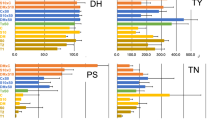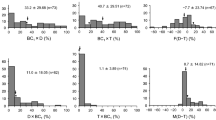Summary
Twelve selections from each of theSolanum tuberosum Groups haploid Tuberosum and Phureja were intercrossed in a NC Design II pattern to generate reciprocal hybrids. Yield parameters, combining ability and variance components were estimated from field experiments conducted at three locations, one in Minnesota and two in Morocco. Heterosis for yield and tuber number was significant at all locations, but only in Tuberosum cytoplasm. Estimates of general combining ability (GCA) for Tuberosum parents and specific combining ability (SCA) for Tuberosum-Phureja combinations varied with location and direction of hybridization. GCA of Phreja parents, however, was consistently significant at all locations and in both cytoplasms. Genetic variance estimates revealed predominantly non-additive gene action for most traits. Environment and direction of hybridization significantly influenced estimates, of variance components, indicating that hybrid performance should be evaluated in both cytoplasms and in the target environments for effective utilization of this germplasm in future breeding efforts.
Similar content being viewed by others
References
Brewbaker, J. L., 1954. Incompatibility in autotetraploidTrifolium repens L. I. Competition and self-compatibility.Genetics 39: 307–316.
Chase, S. S., 1963. Analytic breeding inSolanum tuberosum L. A, scheme utilizing parthenotes and other diploid stocks.Canadian Journal of Genetics and Cytology 5: 359–363.
Comstock, R. E. & H. F. Robinson, 1948. The components of genetic variance in populations of bilateral progenies and their use in estimating the average degree of dominance.Biometrics 4: 254–266.
Comstock, R. E. & H. F. Robinson, 1952. Estimation of average dominance of genes. In: J. W. Gowen (Ed.), Heterosis. Iowa State College Press, Ames, Iowa, p. 494–516.
Cubillos, A. G. & R. L. Plaisted, 1976. Heterosis for yield in hybrids betweenS. tuberosum ssp.Tuberosum andtuberosum ssp.Andigena.American Potato Journal 53: 143–150.
De Jong, H. & G. C. C. Tai, 1977. Analysis of tetraploid-diploid hybrids in cultivated potatoes.Potato Research 20: 111–121.
De, Maine, M. J., 1978. The inheritance, in diploid potatoes, of yield and of rate of sprout growth during storage.Potato Research 21: 163–170.
Glendinning, D. R., 1969. The performance of progenies obtained by crossing GroupsAndigena andTuberosum ofSolanum tuberosum.European Potato Journal 12: 13–19.
Hanneman, R. E., Jr. & S. J. Peloquin, 1967. Crossability of 24-chromosome potato hybrids with 48-chromosome cultivars.European Potato Journal 10: 62–73.
Haynes, F. L., 1972. The use of cultivatedSolanum species in potato breeding. In: E. R. French (Ed.), Prospects for the potato in the developing world: an international symposium on key problems and potentials for greater use of the potato in the developing world, Lima, Peru, July 17–29, 1972. International Potato Center, Lima, p. 100–110.
Hilali, A., F. I. Lauer & R. E. Veilleux, 1987. Reciprocal differences between hybrids ofSolanum tubersosum Groups Tuberosum (haploid) and Phureja.Euphytica 36: 631–639.
Hougas, R. W., S. J. Peloquin & R. W. Ross, 1958. Haploids of the common potato.Journal of Heredity 49: 103–106.
Kempthorne, O., 1957. An introduction to genetic statistics John Wiley and Sons, Inc., New York.
Kidane-Mariam, H. M., H. A. Mendoza & R. O. Wissar, 1983. Combining ability study of tetraploid parental lines for yield and uniformity in true potato seed (TPS) families.American Potato Journal 60: 813. (Abstr.)
Killick, R. J., 1977. Genetic analysis of several traits in potatoes by means of a diallel cross.Annals of Applied Biology 86: 279–289.
Landeo, J. A. & R. E. Hanneman, Jr., 1982a. Heterosis, and combining ability ofSolanum tuberosum Group Andigena haploids.Potato Research 25: 227–237.
Landeo, J. A. & R. E. Hanneman, Jr., 1982b. Genetic variation inSolanum tuberosum Group Andigena haploids.Theoretical and Applied Genetics 62: 311–315.
McHale, N. A. & F. I. Lauer, 1981. Inheritance of tuber traits from Phureja in diploid Phureja-Tuberosum hybrids.American Potato Journal 58: 93–102.
Mendiburu, A. O., S. J. Peloquin & D. W. S. Mok, 1974. Potato breeding with haploids and 2n gametes. In: K. J. Kasha (Ed.), Haploids in higher plants. University of Guelph. Guelph, Ontario, Canada, p. 249–258.
Mok, D. W. S. & S. J. Peloquin, 1975a. Three mechanisms of 2n pollen formation in diploid potatoes.Canadian Journal of Genetics and Cytology 17: 217–225.
Mok, D. W. S. & S. J. Peloquin, 1975b. Breeding value of 2n pollen (diplandroids) in tetraploid x diploid crosses in potatoes.Theoretical and Applied Genetics 46: 307–314.
Mok, D. W. S., S. J. Peloquin & A. O. Mendiburu, 1976. Genetic evidence for mode of 2n pollen formation andS-locus mapping in potatoes.Potato Research 19: 157–164.
Mullin, R. & F. I. Lauer, 1966. Breeding behavior of F1 and inbred potato clones.Proceedings of the American Society for Horticultural Science 89: 449–455.
Paxman, G. J., 1966. Heterosis in Andigena-Tuberosum hybrids. In: John Innes Institute Report for 1965. Bayfordbury, England, p. 51–53.
Plaisted, R. L. & A. G. Cubillos, 1973. Components of yield in potato crosses involving Andigena and Tuberosum germplasms.American Potato Journal 50: 336. (Abstr.)
Plaisted, R. L., L. Sanford, W. T. Federer, A. E. Kehr & L. C. Peterson, 1962. Specific and general combining ability for yield in potatoes.American Potato Journal 39: 185–197.
Quinn, A. A. & S. J. Peloquin, 1973. Use of experimental tetraploids in potato breeding.American Potato Journal 50: 415–420.
Rowe, P. R., 1969. Quantitative variation in diploid potatoes.American Potato Journal 46: 14–17.
Tai, G. C. C., 1976. Estimation of general and specific combing abilities in potato.Canadian Journal of Genetics and Cytology 18: 463–470.
Tarn, T. R. & G. C. C. Tai, 1977. Heterosis and variation of yield components in F1 hybrids between Group Tuberosum and Group Andigena potatoes.Crop Science 17: 517–521.
Thompson, P. G., H. A. Mendoza & R. L. Plaisted, 1983. Estimation of genetic parameters for characters related to potato propagation by true seed (TPS) in an Andigena population.American Potato Journal 60: 393–401.
Veilleux, R. E., 1985. Diploid and polyploid gametes in crop plants: mechanisms of formation and utilization in plant breeding.Plant Breeding Reviews 3: 253–288.
Veilleux, R. E. & F. I. Lauer, 1981. Breeding behavior of yield components and hollow heart in tetraploid-diploid vs. conventionally derived potato hybrids.Euphytica 30: 547–561.
Author information
Authors and Affiliations
Additional information
Scientific Journal Series Article 14,991 of the Minnesota Agricultural Experiment Station supported in part by the U.S. Agency for International Development, contract no. 608-0160, IAV Morocco Project.
Rights and permissions
About this article
Cite this article
Hilali, A., Lauer, F.I. & Veilleux, R.E. Effect of environment and direction of hybridization on genetic variability in two diploid potato populations. Potato Res 31, 247–256 (1988). https://doi.org/10.1007/BF02365533
Accepted:
Issue Date:
DOI: https://doi.org/10.1007/BF02365533




